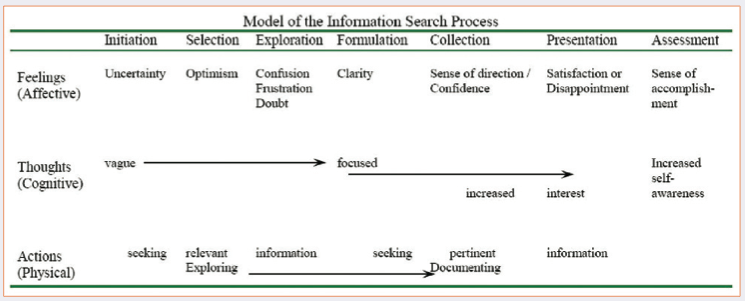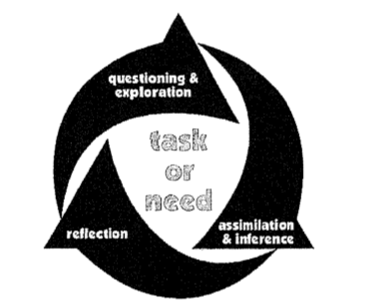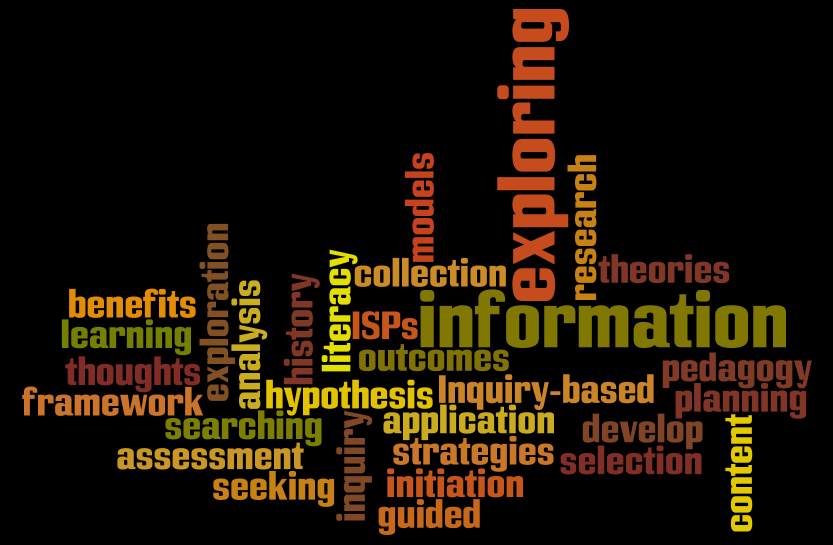To help me understand the search processes undertaken within this blog, I thought it would be valuable to reflect on the relationship of my own inquiry process with certain information seeking and information literacy models.
Kuhlthau’s Model of the Information Search Process (ISP), as pictured below, states that it is important for school librarians and teachers to reflect on the stages of their research to become more aware of how they feel during these stages, how they work through these stages and what strategies they use to help them complete their tasks (p. 17). This will not only help educators understand how extensive searching and learning takes place, however it also prepares them for developing guided inquiry practices for students (Kuhlthau, et al, 2007).
Kuhlthau’s Model of the Information Search Process (ISP), as pictured below, states that it is important for school librarians and teachers to reflect on the stages of their research to become more aware of how they feel during these stages, how they work through these stages and what strategies they use to help them complete their tasks (p. 17). This will not only help educators understand how extensive searching and learning takes place, however it also prepares them for developing guided inquiry practices for students (Kuhlthau, et al, 2007).
As you can see Kuhlthau’s model takes the researcher through 7 stages and during these stages it is useful to document feelings, thoughts and actions to gain a greater insight into the search process. Initiation, the first stage in Kuhlthau’s ISP model is where a unit of study that requires extensive research is announced. During this first stage a student will often feel apprehension at the extent of the task ahead (Kuhlthau, et al, 2007).
After the selection phase when the student has chosen their topic they may again feel a sense of relief but his will shortly be followed by apprehension as they again see how much work they have to complete (Kuhlthau, et al, 2007). During these first two stages of my search process I definitely noticed that my feelings tended to be quite erratic (similar to Kuhlthau’s ISP Model) as I came to terms with the task ahead, but then felt anxious at the amount of work and then elation when I was able to grasp the full extent of the blog.
In the third stage students begin the process of exploration. This is where I began to explore the different search engines and databases, as you can see through my blog posts under “expert search strategies”. In line with Kuhlthau’s model, I did found this one of the most difficult stages within my information searches into inquiry learning and history. I often felt annoyed, confused and frustrated as I used search strings that didn’t return the sources I needed or couldn’t find information pertinent to my topic. However as I continued and gained more confidence in my search strategies, I started to shift into the formulation stage. During this stage I became more focused and able to narrows down my search results in order to gather more relevant information. I then entered the collection stage where I started to select all the relevant sources that I wanted to use in my annotated bibliography. During this stage I felt a sense of direction as I started to cull information that wasn’t needed and keep information that I found extremely relevant to my topic.
Right now I feel that I have entered the presentation stage as I look back on some of my posts and think that I could have done things differently in order. This is usually a time of reflection and self-assessment in terms of what went well and how to approach inquiry learning differently in the future (Kuhlthau, et al, 2007). The last stage in Kuhlthau’s ISP model is devoted to assessment. This is an important stage for both teachers and students as they can both “judge what was learned about content and process and what further learning is needed.” (Kuhlthau, et al, 2007)
Overall I found Kulthau’s ISP model extremely relevant to my own search process however I wanted to examine other ISP models to determine which model best related to my own experiences.
Callison’s Information Inquiry model is based on five stages: questioning, exploration, assimilation, interference and reflection, as pictured below.
After the selection phase when the student has chosen their topic they may again feel a sense of relief but his will shortly be followed by apprehension as they again see how much work they have to complete (Kuhlthau, et al, 2007). During these first two stages of my search process I definitely noticed that my feelings tended to be quite erratic (similar to Kuhlthau’s ISP Model) as I came to terms with the task ahead, but then felt anxious at the amount of work and then elation when I was able to grasp the full extent of the blog.
In the third stage students begin the process of exploration. This is where I began to explore the different search engines and databases, as you can see through my blog posts under “expert search strategies”. In line with Kuhlthau’s model, I did found this one of the most difficult stages within my information searches into inquiry learning and history. I often felt annoyed, confused and frustrated as I used search strings that didn’t return the sources I needed or couldn’t find information pertinent to my topic. However as I continued and gained more confidence in my search strategies, I started to shift into the formulation stage. During this stage I became more focused and able to narrows down my search results in order to gather more relevant information. I then entered the collection stage where I started to select all the relevant sources that I wanted to use in my annotated bibliography. During this stage I felt a sense of direction as I started to cull information that wasn’t needed and keep information that I found extremely relevant to my topic.
Right now I feel that I have entered the presentation stage as I look back on some of my posts and think that I could have done things differently in order. This is usually a time of reflection and self-assessment in terms of what went well and how to approach inquiry learning differently in the future (Kuhlthau, et al, 2007). The last stage in Kuhlthau’s ISP model is devoted to assessment. This is an important stage for both teachers and students as they can both “judge what was learned about content and process and what further learning is needed.” (Kuhlthau, et al, 2007)
Overall I found Kulthau’s ISP model extremely relevant to my own search process however I wanted to examine other ISP models to determine which model best related to my own experiences.
Callison’s Information Inquiry model is based on five stages: questioning, exploration, assimilation, interference and reflection, as pictured below.
Callison’s Information Inquiry model is based on a continuous questioning cycle. During the question stage, questions arise based on previous knowledge and what type of information needs to be obtained. However Callison recognises the cyclic nature of information inquiry and how during the exploration stage action is taken to seek answers for the questions asked (Callison, 2006). Quite often there is a continuous interaction between these two stages as they “drive and refine each other.” (Callison, 2006, p.7) During the exploration stage, questions often become more focused as examination of sources helps refine and focus the questions as more information is obtained. I definitely found this applied to my information searches, as I was able to narrow down my results when I started to learn more about my topic.
During the assimilation stage, the inquirer should not only be involved in reading and listening, but also critical analysis, debate and comparing and contrasting of information, facts and ideas (Callison, 2006, p.8). This is where the inquirer starts to organise new information with what they already know by making links between old and new information altering their accepted knowledge and considering alternatives proposed by the accumulation of new information. The inference stage is also closely linked with assimilation as they work together to form a decision process on accepting and rejecting new information. This is where the inquirer starts to judge information and validate it as relevant and meaningful evidence “that best supports arguments, inferences, and conclusions in a logical, ethical, and convincing manner.” (Callison, 2006, p.9). I can now see how the assimilation and inference stages are so closely linked. As a result of previous knowledge on inquiry learning, I found the assimilation stage quite helpful as I stated to look into not only inquiry learning, but also how inquiry learning works in a History classroom. I then started the process of inference where I would decide how new information related to my topic and whether or not I should keep this new information and assimilate it with prior knowledge or if I should cull according to the relevance of the new information.
Finally, Callison’s model enters the stage of reflection, where the inquirer starts to understand the interactions between all the stages and reflect on how well they have completed the different stages. Once a learner masters self-reflection they are more likely to become more successful independent learners. Lately I have learnt the importance of self-reflection as it helps the learner to understand what aspects they completed well and where there is room for improvement, it is also a critical step within inquiry-based learning, as it enables students to learn from their mistakes.
Overall I definitely agree with Callison’s Information Inquiry model, and found that the stages were extremely relevant to my experiences searching for “information inquiry and history” and then collating my annotated bibliography. I also found the cyclic nature of his model extremely appealing, in that quite often you would go back to different stages as you found new information and learnt more about your topic. I also discovered that with regards to the whole blog, I quite often went though the cycle quite few times with every different expert search, as at the end of each search I would reflect on how it went and what I could do differently next time to improve my search strategies. One limitation with Callison’s model is that he focuses more on the critical analysis of each stage, whilst Kuhlthau addresses the emotive parts of each stage. Kuhlthau’s model also worked in a linear placement, not allowing for movement back to previous stages. I think Kuhlthau’s model would be ideal for students starting to learn more about information search processes as it would help them deal with the emotions of each stage and to understand that during some stages it is quite normal to feel anxious, apprehensive and confused. However I believe that Callison’s model provides a more mature analysis of the information search processes and how all the different stages interact with each other.
References
Callison, D. (2006). Chapter 1: Information Inquiry: Concepts and Elements. In Callison, D. & Preddy, L. The blue book on information age inquiry, instruction and literacy, (pp. 3-16). Westport, Conn: Libraries Unlimited.
Kuhlthau, Carol C. ; Maniotes, Leslie K. & Caspari, Ann K, (2007). Chapter 2: The Theory and Research Basis for Guided Inquiry. In Kuhlthau, Carol C. ; Maniotes, Leslie K. & Caspari, Ann K, Guided inquiry : learning in the 21st century, (pp.13 – 28). Westport, Conn: Libraries Unlimited.
During the assimilation stage, the inquirer should not only be involved in reading and listening, but also critical analysis, debate and comparing and contrasting of information, facts and ideas (Callison, 2006, p.8). This is where the inquirer starts to organise new information with what they already know by making links between old and new information altering their accepted knowledge and considering alternatives proposed by the accumulation of new information. The inference stage is also closely linked with assimilation as they work together to form a decision process on accepting and rejecting new information. This is where the inquirer starts to judge information and validate it as relevant and meaningful evidence “that best supports arguments, inferences, and conclusions in a logical, ethical, and convincing manner.” (Callison, 2006, p.9). I can now see how the assimilation and inference stages are so closely linked. As a result of previous knowledge on inquiry learning, I found the assimilation stage quite helpful as I stated to look into not only inquiry learning, but also how inquiry learning works in a History classroom. I then started the process of inference where I would decide how new information related to my topic and whether or not I should keep this new information and assimilate it with prior knowledge or if I should cull according to the relevance of the new information.
Finally, Callison’s model enters the stage of reflection, where the inquirer starts to understand the interactions between all the stages and reflect on how well they have completed the different stages. Once a learner masters self-reflection they are more likely to become more successful independent learners. Lately I have learnt the importance of self-reflection as it helps the learner to understand what aspects they completed well and where there is room for improvement, it is also a critical step within inquiry-based learning, as it enables students to learn from their mistakes.
Overall I definitely agree with Callison’s Information Inquiry model, and found that the stages were extremely relevant to my experiences searching for “information inquiry and history” and then collating my annotated bibliography. I also found the cyclic nature of his model extremely appealing, in that quite often you would go back to different stages as you found new information and learnt more about your topic. I also discovered that with regards to the whole blog, I quite often went though the cycle quite few times with every different expert search, as at the end of each search I would reflect on how it went and what I could do differently next time to improve my search strategies. One limitation with Callison’s model is that he focuses more on the critical analysis of each stage, whilst Kuhlthau addresses the emotive parts of each stage. Kuhlthau’s model also worked in a linear placement, not allowing for movement back to previous stages. I think Kuhlthau’s model would be ideal for students starting to learn more about information search processes as it would help them deal with the emotions of each stage and to understand that during some stages it is quite normal to feel anxious, apprehensive and confused. However I believe that Callison’s model provides a more mature analysis of the information search processes and how all the different stages interact with each other.
References
Callison, D. (2006). Chapter 1: Information Inquiry: Concepts and Elements. In Callison, D. & Preddy, L. The blue book on information age inquiry, instruction and literacy, (pp. 3-16). Westport, Conn: Libraries Unlimited.
Kuhlthau, Carol C. ; Maniotes, Leslie K. & Caspari, Ann K, (2007). Chapter 2: The Theory and Research Basis for Guided Inquiry. In Kuhlthau, Carol C. ; Maniotes, Leslie K. & Caspari, Ann K, Guided inquiry : learning in the 21st century, (pp.13 – 28). Westport, Conn: Libraries Unlimited.




